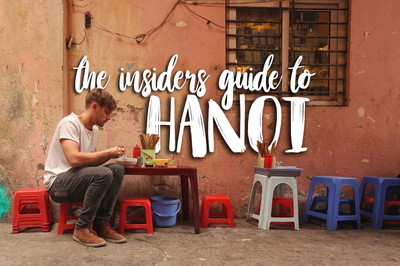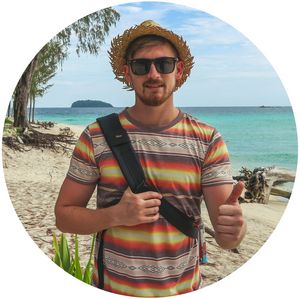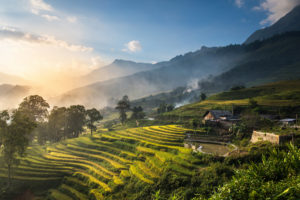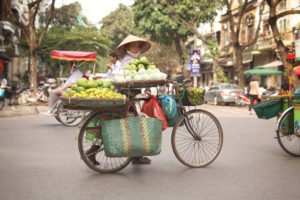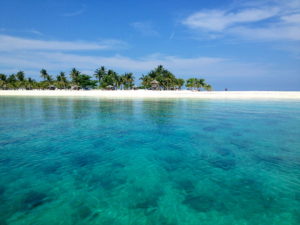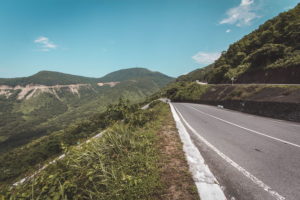5 Day Ma Pi Leng Pass Itinerary (from Hanoi)
The Ma Pi Leng Pass is Vietnam’s final frontier. This scenic route winds its way through towering mountains in the far northern reaches of Vietnam. Out here, you will visit small ethnic villages, find almost vertical farms on the mountainside, and ride through some of Asia’s most stunning scenery.
Ideally, the Ma Pi Leng Pass should be done over three or more consecutive days. The distances covered are relatively short, but don’t let that fool you into thinking this is a one day ride.

The potholed roads are steep and winding, often blanketed by thick fog which conceals unexpected roads works. Road barriers in many places are non-existent. A mistake leads to 500-meter plunge to the valley below.
In some sections, the route is so remote in parts that even a minor breakdown means hours and hours of delay. To put this into perspective, it took us four hours to wheel a motorbike with a flat tire to the next farmer’s hut. Luckily there was a tire pump available.
However, when the fog clears up you will be looking at some of the most amazing views in all of Asia. You will have the chance to meet people from a culture you will not find elsewhere and possibly never see again.
So, why rush through the Ma Pi Leng Pass in a day when you can slow down and soak it all in?
Day 1: Getting ready in Hanoi for the Ma Pi Leng Pass
Some travelers venture north from Ho Chi Minh City or east from Sapa. If this is your plan then be sure to check out my comprehensive Vietnam Travel Itinerary.
However, it is likely Hanoi will be the starting point for your adventure on the Ma Pi Leng Pass. So if you are starting off in the north then be sure to check out my Hanoi travel guide too.
Before the adventure begins, it is time to ready with some essential equipment. I suggest preparing with the following items either in Hanoi, or buying online before going to Vietnam:
- Motorbike – hire a decent motorbike just outside of the Old Quarter. You can pick up entry range Honda Wins and Minsks at street side mechanics from USD 10 per day. With a bigger budget, consider the XR250 or DRZ400 with Flamingo Travel.
- Road Atlas – a decent road atlas will uncover small trails that do not appear on fold-out maps. There are routes here which don’t even appear on google maps unless you know what you’re looking for. I recommend getting the Road Atlas of Vietnam even before heading to Asia. It is a lifesaver when your phone runs out of battery or internet connection.
- Wet weather gear – definitely go for a decent set of wet weather riding gear before you head to Vietnam. Quality wet weather goods in Hanoi are difficult to come by.
- LED Headlamp – if and when your motorbike headlight fails, this will be your only source of light. I suggest getting a high powered LED headlamp.
- Thermal Innerwear – though you may think Southeast Asia is all hot and humid, it is a different story at over 2000m altitude. I highly recommend North Face inner thermals. They come at a premium but keep you warm when the going gets cold (i.e. below zero degrees).
Day 2: Hanoi to Ha Giang

Ha Giang (pronounced ha siang) is the gateway to Vietnam’s northern mountain ranges. From here, you will venture up into the mountainous roads where cars are a rare sight. First, you must battle Hanoi.
Depart Hanoi nice and early because there is a long 300km ride ahead to Ha Giang. Unless you are on a 250cc motorbike or larger this ride will probably take the best part of 6 to 10 hours.
There are a few different routes of getting from Hanoi to Ha Giang, however, the quickest method for motorbike is the QL2C. Motorbikes cannot use the CT05 expressway, and regardless it would not be a safe route due to trucks.
Each time I have stayed in Ha Giang over the past few years I’ve tried out a different hotel. I definitely suggest staying a night at the Truong Xuan Resort. It costs slightly more than other hotels but you will get a decent bed, hot shower, a great dinner menu and of course cold beers available in the restaurant. All a great way to end a long day of riding.
Day 3 – Ha Giang to Dong Van (Ma Pi Leng Pass #1)

Ha Giang to Dong Van following route QL4C is essentially the first half of the Ma Pi Leng Pass. Though the route is only 137km, it will take a lot longer than you think.
The route from Ha Giang to Dong Van is that steep, winding, potholed and foggy road you read about in this articles intro. It is a motorcycle adventure packed with great views and small mountain villages.
While Ha Giang itself may not be very foggy, things can change rather quickly. The fog is patchy and can be so thick that it is difficult to see another motorbike just 5 meters in front of you.
My advice: take it easy.

Some suggest that Dong Van is an ugly town situated on the highway. They could not be more wrong.
Yes, the main strip of the town is located right on the highway. However, explore a little further though and you will discover a nice small village market, cozy homestays and coffee houses in back alleyways, and a community farm tucked away and out of sight.
Check out the Bui Homestay for some authentic local style accommodation just outside of town.
Day 4 – Dong Van to Meo Vac (Ma Pi Leng Pass #2)



The road from Dong Van to Meo Vac is the section officially regarded as the Ma Pi Leng Pass. This route might only be 22km, however, it is the most incredible 22km you will travel in all of Southeast Asia.
Between Dong Van and Meo Vac, the mountain range reaches so high that you’ll forget you’re in Vietnam. The steepest mountains lush with greenery. The scenery most closely resembles something out of James Cameron’s Avatar.
The mountain’s lower half is cultivated with the most impressive farming practices I have ever seen. Where it seems impossible to walk there will be buffalo tilling the earth in front a 70-year-old ethnic villager while carrying a baby slung over one shoulder.

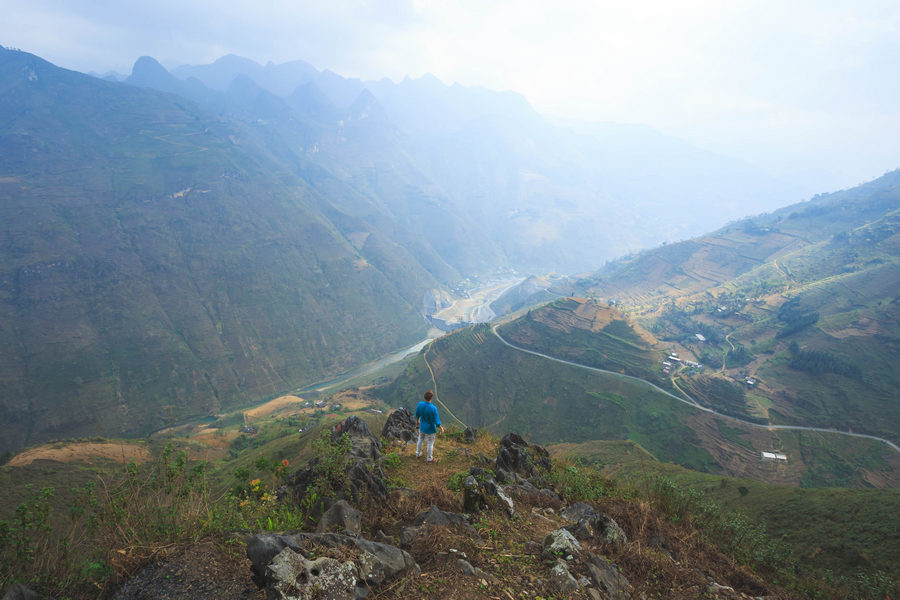
The local children are curious of westerners, a rare sight out in these remote parts of Vietnam. Stop to say hi and they will start asking questions in a local ethnic dialect, more similar to Chinese than the Vietnamese language.
Then there are impressive views over the Chinese borders. Hundreds of meters down below the Nho Que River separates the two countries. Beyond the river, there are mountains continuing into China’s southern Yunnan Province.
Reaching Meo Vac was a significant achievement for us. The Ma Pi Leng Pass should have taken two hours at a leisurely pace, but took more than six hours. This is where breakdowns and flat tires came to haunt us all day.
Day 5 – Beyond Meo Vac
There are several options for continuing beyond Meo Vac:
- Go south to Hanoi via Ba Bae Lake
- Turn around a go back to Ha Giang
- Go east towards Cao Bang Province
Our adventure takes option three, continuing east from the Ma Pi Leng Pass to the rural province of Cao Bang.
We venture off-road mountain routes where motorbikes should not go. Further east we make it to the huge Ban Gioc Waterfall on the Chinese border and spend a night at a rural Vietnamese homestay.
Cao Bang is yet another remote and underrated area of Vietnam that most travelers simply do not make the effort to reach.
Of course, riding a motorbike in Vietnam can have its mishaps. Breakdowns are common. Flat tires, a snapped motorbike frame, a broken rear swing arm, an exhaust which all but fell off, running out of fuel in the middle of nowhere and simply clogging up the air filter with too much two-stroke oil.
MORE AWESOME VIETNAM ARTICLES YOU’LL LOVE
[one_third]
[/one_third]
[one_third]
[/one_third]
[one_third_last]
[/one_third_last]
USEFUL PRODUCTS FOR YOUR TRIP
Loved this blog post? Please share on social media



